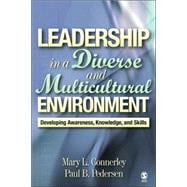
What is included with this book?
| Foreword | ix | ||||
|
|||||
| Preface | xi | ||||
| Acknowledgments | xv | ||||
| 1. Making the Business Case for Increased Awareness, Knowledge, and Skills | 1 | (20) | |||
|
3 | (1) | |||
|
4 | (2) | |||
|
6 | (2) | |||
|
8 | (1) | |||
|
9 | (4) | |||
|
13 | (4) | |||
|
17 | (1) | |||
|
17 | (1) | |||
|
17 | (1) | |||
|
18 | (3) | |||
| 2. The Complexity of Culture | 21 | (18) | |||
|
22 | (1) | |||
|
23 | (1) | |||
|
24 | (1) | |||
|
25 | (3) | |||
|
28 | (2) | |||
|
30 | (1) | |||
|
31 | (3) | |||
|
34 | (1) | |||
|
35 | (1) | |||
|
36 | (1) | |||
|
36 | (1) | |||
|
37 | (2) | |||
| 3. Cultural Frameworks and Their Importance for Leaders | 39 | (16) | |||
|
40 | (1) | |||
|
41 | (1) | |||
|
42 | (3) | |||
|
45 | (2) | |||
|
47 | (1) | |||
|
47 | (2) | |||
|
48 | (1) | |||
|
48 | (1) | |||
|
49 | (1) | |||
|
49 | (2) | |||
|
51 | (1) | |||
|
52 | (1) | |||
|
52 | (1) | |||
|
53 | (2) | |||
| 4. Where Does One Start on the Journey to Multicultural Awareness, Knowledge, and Skills? | 55 | (14) | |||
|
57 | (2) | |||
|
59 | (2) | |||
|
59 | (1) | |||
|
60 | (1) | |||
|
61 | (1) | |||
|
62 | (1) | |||
|
63 | (2) | |||
|
65 | (1) | |||
|
66 | (1) | |||
|
66 | (1) | |||
|
66 | (1) | |||
|
67 | (2) | |||
| 5. The Development of Multicultural Competencies | 69 | (20) | |||
|
70 | (4) | |||
|
74 | (11) | |||
|
74 | (3) | |||
|
77 | (3) | |||
|
80 | (5) | |||
|
85 | (1) | |||
|
85 | (1) | |||
|
85 | (1) | |||
|
86 | (3) | |||
| 6. What Can We Do to Make Multicultural and Diversity Training More Effective? | 89 | (22) | |||
|
90 | (5) | |||
|
91 | (1) | |||
|
92 | (1) | |||
|
93 | (2) | |||
|
95 | (7) | |||
|
102 | (2) | |||
|
104 | (1) | |||
|
104 | (1) | |||
|
105 | (1) | |||
|
105 | (1) | |||
|
|||||
|
106 | (5) | |||
| 7. A Training Program to Lead From Multicultural Awareness to Knowledge and Skills | 111 | (18) | |||
|
112 | (2) | |||
|
114 | (2) | |||
|
114 | (1) | |||
|
115 | (1) | |||
|
116 | (1) | |||
|
116 | (7) | |||
|
116 | (4) | |||
|
120 | (1) | |||
|
121 | (2) | |||
|
123 | (2) | |||
|
125 | (1) | |||
|
125 | (1) | |||
|
126 | (1) | |||
|
126 | (1) | |||
|
127 | (2) | |||
| 8. Constructive Conflict Management in a Cultural Context | 129 | (22) | |||
|
130 | (3) | |||
|
133 | (1) | |||
|
134 | (2) | |||
|
136 | (2) | |||
|
138 | (3) | |||
|
141 | (3) | |||
|
144 | (1) | |||
|
145 | (2) | |||
|
146 | (1) | |||
|
147 | (1) | |||
|
147 | (4) | |||
| 9. Redefining Leadership Through Multiculturalism | 151 | (14) | |||
|
152 | (2) | |||
|
154 | (2) | |||
|
156 | (3) | |||
|
159 | (1) | |||
|
160 | (1) | |||
|
160 | (1) | |||
|
161 | (1) | |||
|
161 | (4) | |||
| Appendix | |||||
|
165 | (3) | |||
|
168 | (9) | |||
|
168 | (1) | |||
|
169 | (1) | |||
|
170 | (1) | |||
|
171 | (6) | |||
| References | 177 | (22) | |||
| Name Index | 199 | (8) | |||
| Subject Index | 207 | (8) | |||
| About the Authors | 215 |
The New copy of this book will include any supplemental materials advertised. Please check the title of the book to determine if it should include any access cards, study guides, lab manuals, CDs, etc.
The Used, Rental and eBook copies of this book are not guaranteed to include any supplemental materials. Typically, only the book itself is included. This is true even if the title states it includes any access cards, study guides, lab manuals, CDs, etc.